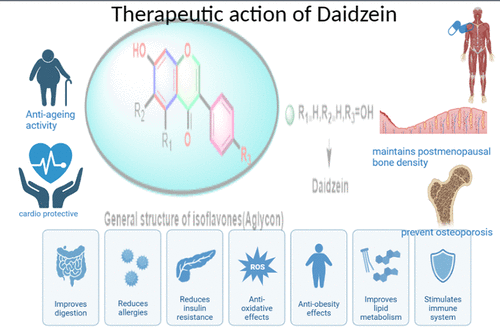
Daidzein (DDZ) is a well-known nutraceutical supplement belonging to the class of isoflavones. It is isolated from various sources such as alfalfa, soybean, and red clover. It demonstrates a broad array of pharmacological/beneficial properties such as cardiovascular exercise, cholesterol reduction, and anticancer, antifibrotic, and antidiabetic effects, which make it effective in treating a wide range of diseases. Its structure and operation are the same as those of human estrogens, which are important in preventing osteoporosis, cancer, and postmenopausal diseases. It is thus a promising candidate for development as a phytopharmaceutical. Addressing safety, efficacy, and physicochemical properties are the primary prerequisites. DDZ is already ingested every day in varying amounts, so there should not be a significant safety risk; however, each indication requires a different dose to be determined. Some clinical trials are already being conducted globally to confirm its safety, efficacy, and therapeutic potential. Furthermore, as a result of its therapeutic influence on health, in order to establish intellectual property, patents are utilized. In light of the vast potential of eugenol, this review presents a detailed data collection on DDZ to substantiate the claim to develop it in the therapeutic category.
This publication is licensed under
More info please click the source

Sales Office:
Wuhan Ability chemical technology Co., Ltd.
Add:No 518 Qingnian Rd., Jianghan, Wuhan, Hubei Province, 430024, P.R.China.
Tel:0086-27-85788889
E-mail: sales@lthxy.com
Copyright(C)2023, Luotian Xinpusheng Pharmaceutical Co., Ltd. All Rights Reserved. Supported by ChemNet
XML privacy policy
We use cookies to understand how you use our site and to improve the overall user experience. This includes personalizing content and advertising. Read our Privacy Policy